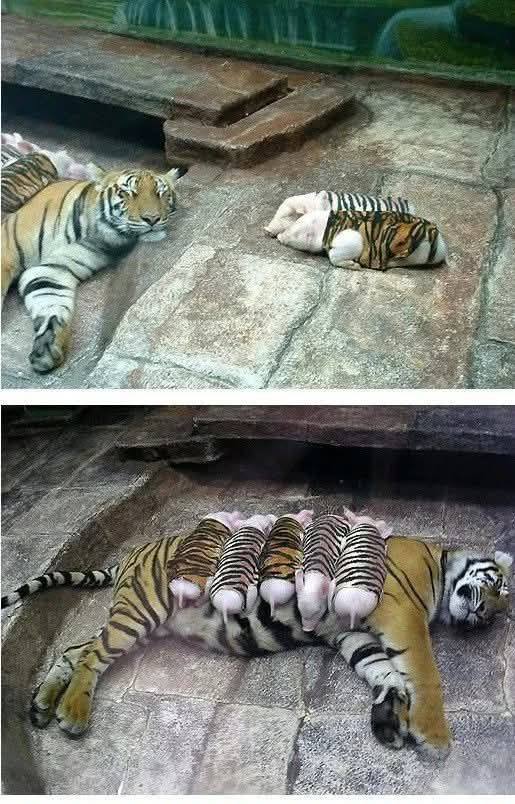The Striped Family: How a Tigress and Her Adopted Piglets Touched the Hearts of Millions

 The Striped Family: How a Tigress and Her Adopted Piglets Touched the Hearts of Millions
The Striped Family: How a Tigress and Her Adopted Piglets Touched the Hearts of Millions
In a world where natural instincts often dictate survival, an extraordinary story of compassion, healing, and the unbreakable bond of motherhood has emerged from a zoo in Thailand. The scene is almost surreal: a powerful tigress calmly lying on a stone floor, her body relaxed and protective as a group of tiny piglets, each wrapped in a tiger-striped outfit, cuddle and nurse from her. This unusual but heartwarming family has captivated millions worldwide, turning into a viral symbol of love that defies nature’s rules.
What at first glance may appear to be a carefully staged photo opportunity is, in fact, a deeply emotional and instinct-driven story rooted in loss, healing, and human empathy. The tale of this striped family began not in joy, but in tragedy.
A Mother’s Grief: The Tigress’s Tragic Loss
According to reports from the Sriracha Tiger Zoo in Chonburi, Thailand—where these unforgettable images were taken—the mother tigress had recently lost her own litter of cubs shortly after birth. The reasons varied from health complications to unknown environmental factors, but the result was heartbreaking: the tigress was left alone and visibly depressed.
Zookeepers observed a noticeable shift in her behavior. She stopped eating regularly, isolated herself from the other tigers, and refused to engage with her environment. The normally majestic and alert predator had become lethargic and sorrowful. Like many mothers across the animal kingdom, the bond between the tigress and her cubs was strong. The sudden separation plunged her into what experts likened to mourning.
Recognizing her grief and the risk it posed to her health, the zoo staff sought a creative and compassionate way to help the tigress recover. What followed was both unprecedented and inspiring.
An Unlikely Solution: Piglets in Disguise
In an unconventional but ultimately brilliant move, caretakers introduced a litter of newborn piglets into the tigress’s enclosure. The twist? Each piglet wore a custom-made outfit resembling tiger stripes. The idea was simple but daring: trick the tigress’s instincts just enough to evoke a maternal response, and possibly provide her with the healing comfort of caring for “offspring” again.
The team held their breath as the piglets were gently placed near the tigress. To their amazement—and immense relief—the plan worked. The tigress approached the piglets cautiously at first, sniffing them, nudging them gently with her nose. Then, in a gesture that stunned onlookers, she lay down beside them, allowing them to nurse. She licked them as she would her own cubs, curling her body around them protectively.
The piglets, for their part, seemed perfectly at ease. Perhaps sensing no threat, they quickly snuggled against her warm fur, making themselves at home. The unlikely bond was formed.

Motherhood Without Borders: The Science Behind Cross-Species Adoption
Cross-species adoption is not unheard of in the animal kingdom, but it is relatively rare—especially between predator and prey. Scientists and animal behaviorists point out that maternal instincts can, at times, override natural hunting behaviors, particularly when a mother is grieving or hormonal changes are involved.
Dr. Linda Porter, a zoologist specializing in animal maternal behavior, explains:
“In some species, the need to nurture is so powerful that it can be redirected when a mother loses her own young. The presence of small, warm-bodied, nursing animals—even if they’re not of the same species—can trigger that instinct. It’s not about logic. It’s about an emotional and biological response to loss.”
This particular case is remarkable not only because the tigress adopted animals that would typically be her prey but also because of the seamless acceptance of the piglets. It suggests a deep, intuitive recognition of innocence and vulnerability that transcends the species divide.
Public Reaction: A Global Outpouring of Emotion
The images quickly made their way onto social media, where they were shared, re-shared, and turned into memes, inspirational quotes, and news stories. Captions like “Love knows no species” and “A mother’s heart sees no stripes” spread across platforms like wildfire.
People around the world reacted with awe, some brought to tears, others filled with admiration for the caretakers who devised such a humane and touching intervention. The story resonated across cultures, perhaps because it reflected something universally human: the innate need to love and be loved, even in the face of loss.
Online forums overflowed with comments such as:
“This is the most beautiful thing I’ve seen all year.”
“Proof that love can conquer instinct.”
“We have so much to learn from animals.”
Teachers used the story in classrooms to spark discussions about empathy. Parents shared the images with their children to teach about kindness and compassion. Animal lovers posted tributes and artwork. Some even suggested that this story could be turned into a children’s book or animated film—and it wouldn’t be surprising if it eventually is.
Zoo Ethics and the Role of Human Intervention
Of course, stories like this also raise important ethical questions. Is it right to interfere with an animal’s emotional process? Were the piglets in any danger? How much human influence is acceptable in the world of wild animals?
The zoo, in response to these questions, clarified that the piglets were in no danger. They were carefully monitored, and veterinary staff were on standby at all times. Additionally, the decision to introduce the piglets was made after consulting with animal behavior experts.
In this case, the intervention likely saved the life of the tigress, who may have otherwise succumbed to illness or depression. It also provided the piglets with an extraordinary early experience—one that, although unusual, was not harmful to their development.
The incident raises broader discussions about animal sentience, emotional intelligence, and how zoos can act not only as places of display but also of care, healing, and learning.
The Bigger Picture: What This Story Teaches Us
In an era often dominated by division, violence, and the harsh realities of the natural world, this story stands out as a symbol of hope. It shows us that compassion can thrive in the most unexpected places, even between a tiger and a piglet. It reminds us that love is not always defined by biology, and that sometimes, the most powerful bonds are the ones formed by need, empathy, and shared vulnerability.
From a psychological standpoint, the story also illustrates the healing power of caregiving. Just as humans often recover from grief through acts of nurturing—raising a child, adopting a pet, mentoring others—so too can animals rediscover purpose through loving actions.
The tigress, once on the verge of decline, now appears revitalized and emotionally stable. She plays with the piglets, responds to their cries, and guards them as fiercely as she would her own. In turn, the piglets flourish under her warmth and protection.
Where Are They Now? The Future of the Striped Family
According to recent updates from the zoo, the piglets and tigress continue to do well. As the piglets grow, they will eventually be weaned and moved to an appropriate habitat. The tigress will undergo careful evaluation to ensure her emotional health remains strong, and she may be introduced to new tiger cubs in the future if appropriate.
Meanwhile, the zoo has turned the story into an educational exhibit, using it to teach visitors about animal behavior, cross-species empathy, and the importance of conservation. Informational plaques, videos, and guided tours explain the context behind the images, ensuring that visitors see more than just a cute photo—they see a story of resilience and compassion.
Love That Transcends Nature
The world is filled with stories of survival, strength, and struggle. But every so often, a story comes along that reminds us of the soft edges within even the fiercest creatures. The tale of the tiger and the piglets is one of those stories—a rare and beautiful testament to the fact that love doesn’t always follow the rules of nature. Sometimes, it simply finds a way.
This striped family is more than just a viral sensation. It is a symbol of hope, a lesson in empathy, and a call to see beyond our differences. If a tigress can nurture her natural prey, perhaps there is more capacity for peace, understanding, and compassion in the world than we think.
Let us take this lesson to heart—not just in zoos or stories, but in our daily lives, our communities, and our interactions with those who are different from us. Because sometimes, the most unlikely families turn out to be the most inspiring.











